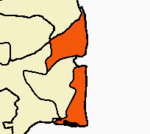Chudamani Vihara
Chudamani Vihara was a Buddhist vihara (monastery) in Nagapattinam, Tamil Nadu, India. Chudamani Vihara was constructed in 1006 CE[1] by the Srivijayan king Sri Vijaya Maravijayattungavarman with the patronage of Rajaraja Chola.[2][3] The vihara building survived in dilapidated condition. Since 1856, about 350 Buddha bronzes have been found at Nagapattinam, dating from the 11th to the 16th century.[1]
History
The heritage of Nagapattinam is mentioned in the Burmese historical text of 3rd century B.C. which mentions a Buddha vihara built by the emperor Ashoka. The Chinese traveler Xuanzang also mentioned the vihara. Nagappattinam is mentioned as Padarithitha in the ancient Buddhist literature. [citation needed]
The Anaimangalam copperplate of Kulothunga Chola I mentions that Kasiba Thera (Buddhist Monk) renovated the shrine in 6th century AD with the help of monks of "Naganadu" (Nagapattinam). The Pallava King Rajasimha (690–728) permitted a Chinese king to build Buddha vihara in Nagappattinam.[4]
According to the copperplate record of Chola king Rajaraja, the Sailendra king, Sri Mara-vijayottunga-varman constructed the vihara with the support of Rajaraja.[citation needed]
It is written in Ponniyin Selvan by Kalki that the copperplate was moved to Leiden Museum (Holland).[citation needed]
One statue, now at John D. Rockefeller Collection of Asian Art in New York, has an inscription that mentions that this Buddha was created to be carried in a procession during the temple’s sacred festival. The inscription has been translated by Vidya Dehejia as:
- Well-being [and] prosperity. The nayakar [Buddha], of all of the eighteen countries, of the metalworkers. The procession image, for the sacred festival of the alvar temple, which was caused to be taken in procession by the respected one (utaiyar) endowed of the four gunas from Cirutavur; [in] the perum-palli (great place of worship or great vihara) of the metalworkers, [in] the perum-palli of Rajendra Chola.[5]
Notes
- ^ a b "buddhist teachings hindu meditation tibetan at buddhistnews.tv". Archived from the original on 9 October 2014. Retrieved 21 June 2006.
- ^ Keay, John, India: A History, pp 222-223
- ^ "Archived copy" (PDF). Archived from the original (PDF) on 8 February 2007. Retrieved 16 October 2006.
{{cite web}}: CS1 maint: archived copy as title (link) - ^ South Indian Inscriptions, Volume 12, ASI
- ^ Asia Society: The Collection In Context Archived 2006-06-26 at the Wayback Machine
- The Chudamani Vihara was demolished by a tsunami a while after the visit of The Chinese traveler Xuanzang
References
- Keay, John (2001). India: A History. New York: Grove Press. ISBN 0-8021-3797-0.
{{cite book}}: Cite has empty unknown parameter:|coauthors=(help)
External links
- Buddha 14th century Formerly in the collection of Mrs. W. van Hoogstraten-Fetlaer, Netherlands.
- Bodhi's Tamil Afterglow Outlook India, 7 July 2004
- Nagapattinam Buddhas at the Chennai Museum
- Buddha Shakyamuni Norton Simon Museum
- Buddha Shakyamuni Art Institute of Chicago
- procession Buddha John D. Rockefeller Collection of Asian Art in New York
- Buddha, 12th century[permanent dead link] Art Institute of Chicago
- Tracing the Sri Lanka-Kerala link Hindustan Times 23 March 2006

